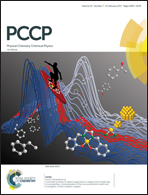Oxidizing CO2 with superhalogens
Abstract
The possibility of oxidizing carbon dioxide molecule using the series of SbnF5n+1 (n = 1–3) superhalogen systems was investigated on the basis of quantum chemistry calculations performed using the QCISD and B3LYP methods and the 6-311+G(d)/LANL2DZ basis sets. The Sb3F16 species was found to be capable of forming a stable and strongly bound ionic Sb3F16−/CO2+ compound when combined with the CO2 molecule, whereas the remaining SbF6 and Sb2F11 species were predicted to form only weakly bound complexes. The conclusions concerning the ionic character of the Sb3F16−/CO2+ resulting compound are supported by the discussion of the binding energy values, charge flow between the interacting fragments, and localization of the unpaired electron spin density.



 Please wait while we load your content...
Please wait while we load your content...